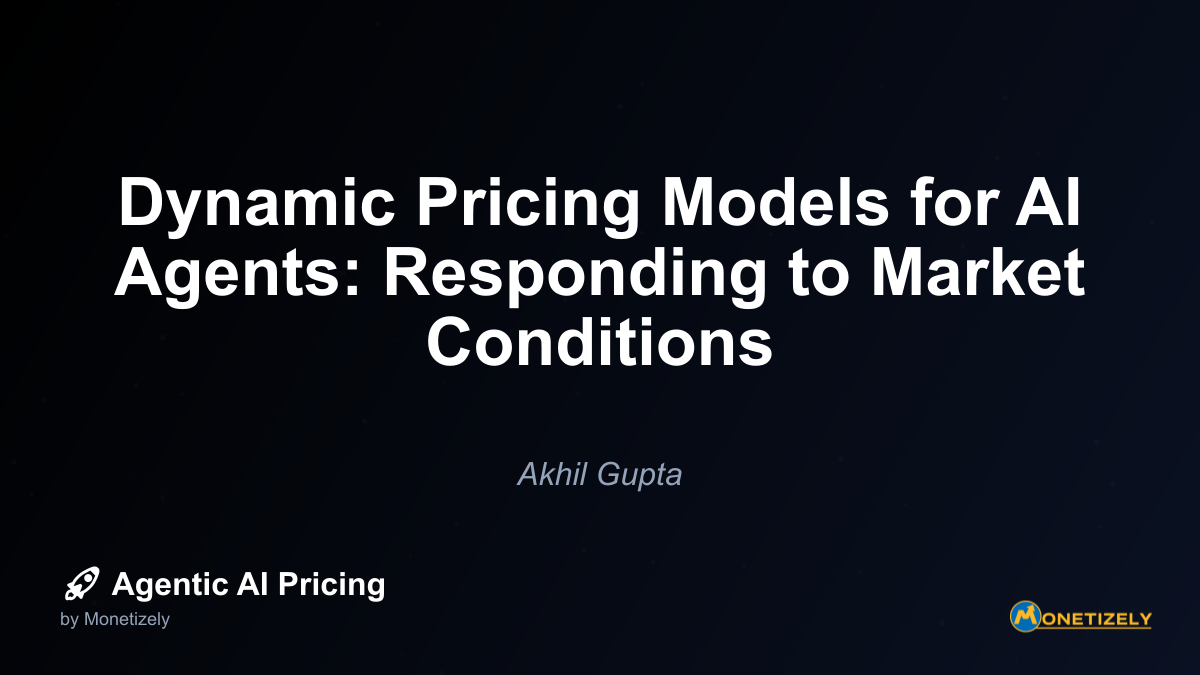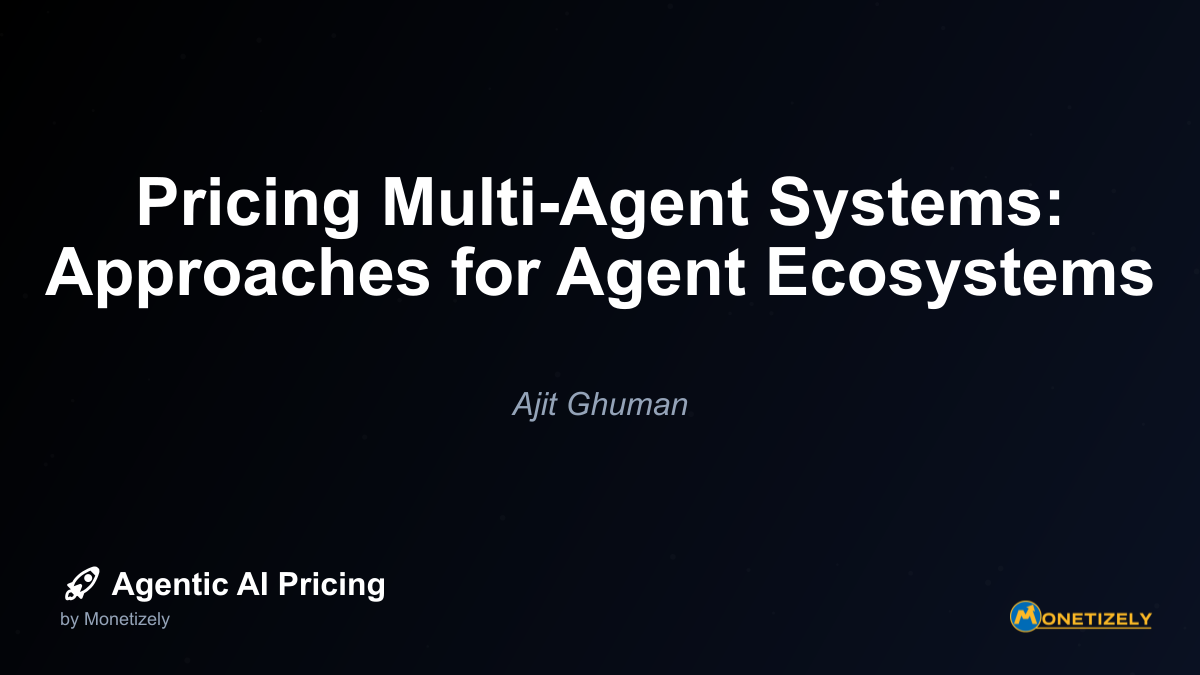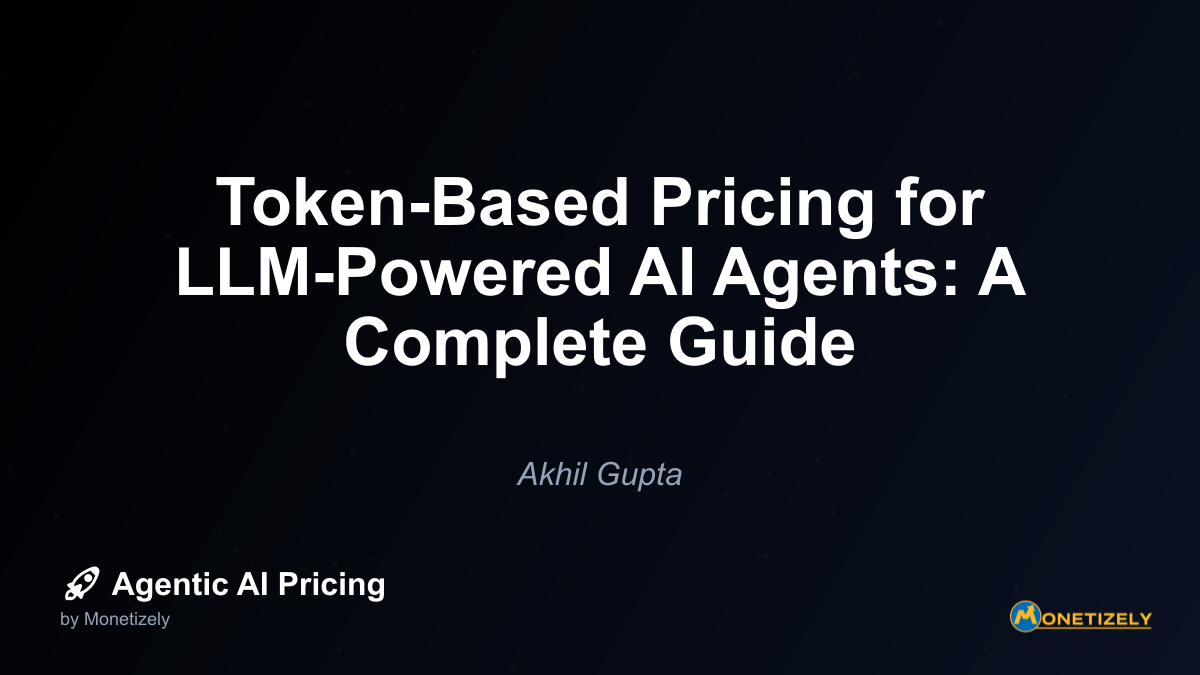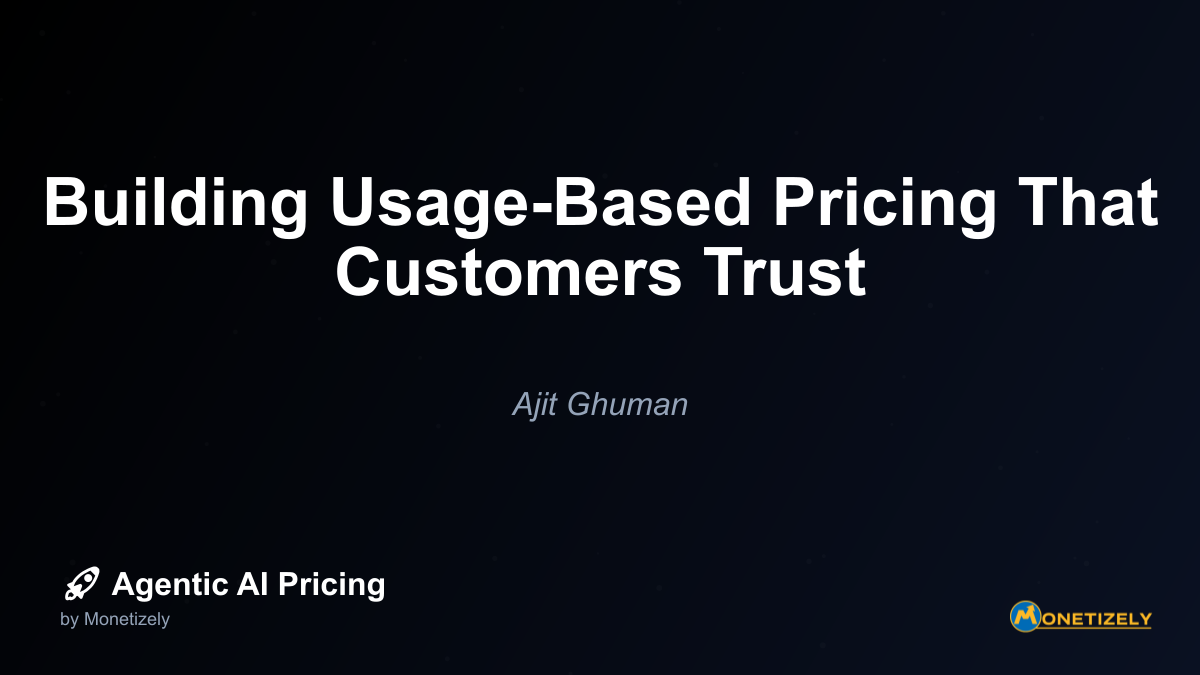· Akhil Gupta · AI Pricing Models · 12 min read
Pricing AI-Human Hybrid Services: Finding the Right Balance
AI and SaaS Pricing Masterclass
Learn the art of strategic pricing directly from industry experts. Our comprehensive course provides frameworks and methodologies for optimizing your pricing strategy in the evolving AI landscape. Earn a professional certification that can be imported directly to your LinkedIn profile.
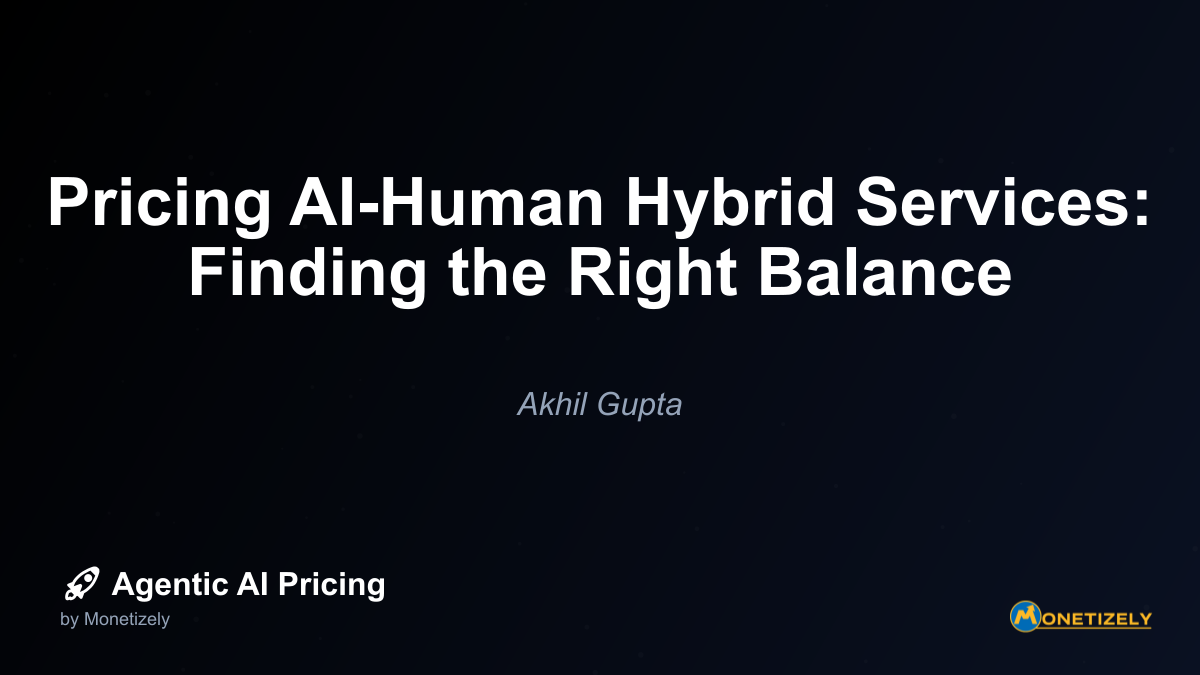
In the rapidly evolving landscape of artificial intelligence, the integration of AI with human expertise is creating a new paradigm for service delivery. This hybrid approach combines the scalability and consistency of AI with the nuanced judgment and emotional intelligence of humans. However, finding the right pricing model for these hybrid services presents unique challenges that organizations must navigate to maximize value while ensuring sustainable operations.
The Rise of AI-Human Hybrid Services
The market for AI-human hybrid services is experiencing explosive growth, driven by the recognition that neither AI nor humans alone can deliver optimal results across all service contexts. According to recent market research, the hybrid AI market is projected to grow at a compound annual growth rate (CAGR) of approximately 30% from 2023 through 2030, potentially reaching nearly $50 billion by 2030.
This growth is fueled by compelling evidence of effectiveness. Organizations implementing AI-human hybrid models report an average ROI of $3.50 for every $1 invested, with top performers achieving up to 8x returns. Salesforce customers attribute an average 37% revenue increase to AI implementation, while McKinsey reports that 8% of organizations attribute 20% or more of their EBIT (earnings before interest and taxes) to AI.
The adoption of hybrid models spans multiple sectors:
Customer service: By 2025, 95% of customer interactions are expected to be AI-powered, with 80% of customer service organizations implementing generative AI. This reflects a model where AI handles routine inquiries while humans manage complex or emotionally charged interactions.
Healthcare: Radiologists use AI to augment MRI diagnostic accuracy and speed, with AI handling data-intensive tasks like highlighting abnormalities while physicians make final diagnostic decisions.
Financial services: AI systems detect patterns and anomalies in transactions, with human analysts providing final judgment on complex cases or high-value decisions.
The key to success in these hybrid models lies not just in the technology itself, but in thoughtfully designed workflows that leverage the strengths of both AI and human components. This extends to pricing strategies, which must reflect the unique value proposition of the hybrid approach.
Understanding the Value Components of Hybrid Services
Before establishing pricing for AI-human hybrid services, it’s essential to understand the distinct value components that each brings to the table:
AI Component Value
Scalability and consistency: AI can handle virtually unlimited volume with consistent quality, making it ideal for repetitive tasks.
Speed and availability: AI operates 24/7 without breaks, providing immediate responses regardless of time or demand spikes.
Pattern recognition and data processing: AI excels at analyzing vast datasets to identify patterns that might escape human notice.
Cost efficiency for routine tasks: For standardized, well-defined processes, AI typically costs a fraction of human labor (e.g., $0.50 per chatbot interaction vs. $6.00 per human interaction).
Human Component Value
Judgment and critical thinking: Humans excel at making nuanced decisions in ambiguous situations where context and implications matter.
Emotional intelligence and empathy: Human agents can recognize and respond appropriately to customer emotions, building trust and rapport.
Creative problem-solving: For novel situations without precedent, humans can improvise solutions that AI cannot yet formulate.
Ethical oversight and accountability: Humans provide necessary judgment for ethically complex decisions and take responsibility for outcomes.
Hybrid Value Multiplier
The combination of AI and human components often creates value greater than the sum of its parts:
Augmented human capabilities: AI can provide real-time information and suggestions to human agents, enhancing their performance and decision quality.
Optimized resource allocation: Routine matters handled by AI free human resources for higher-value activities.
Reduced error rates: AI can catch human errors, while humans can identify AI limitations, creating a more robust system overall.
Enhanced customer experience: The right balance provides both efficiency and personalization, leading to higher satisfaction and retention.
Understanding these value components is crucial for developing pricing models that accurately reflect the service’s worth to customers while ensuring sustainable operations for providers.
Common Pricing Models for AI-Human Hybrid Services
Several pricing models have emerged for AI-human hybrid services, each with distinct advantages and considerations:
1. Tiered Subscription Models
Tiered subscription models offer different levels of service at corresponding price points, typically structured around the degree of human involvement and service sophistication.
Structure:
- Basic Tier: Primarily AI-driven with limited or no human intervention
- Standard Tier: AI with human oversight and escalation capabilities
- Premium Tier: Enhanced human expertise with AI augmentation
- Enterprise Tier: Customized AI-human integration with dedicated human resources
Example: A customer service platform might offer:
- Basic ($50/month): AI chatbot handling standard inquiries
- Standard ($200/month): AI chatbot with human escalation for complex issues
- Premium ($500/month): Dedicated human agents with AI assistance
- Enterprise (Custom pricing): Tailored solution with dedicated team and customized AI
Advantages:
- Predictable recurring revenue
- Clear value differentiation
- Allows customers to select their optimal balance of cost vs. service level
- Opportunity for upselling as customer needs evolve
Considerations:
- May not align perfectly with actual resource utilization
- Risk of cannibalization between tiers
- Requires careful design of tier boundaries and capabilities
2. Usage-Based Pricing
Usage-based pricing ties costs directly to consumption of specific service components, whether AI processing or human time.
Structure:
- Charges based on volume metrics (e.g., number of interactions, processing time)
- Separate rates for AI and human components
- Potential for volume discounts at higher usage levels
Example: A document processing service might charge:
- $0.05 per page for AI processing
- $2.00 per page requiring human review
- Volume discounts applied after 10,000 pages monthly
Advantages:
- Direct alignment between usage and cost
- Transparency in resource utilization
- Lower entry barrier for customers with uncertain needs
- Scales naturally with customer growth
Considerations:
- Less predictable revenue for the provider
- Potential for bill shock if usage spikes unexpectedly
- Requires robust usage tracking and billing systems
- May discourage usage that would create customer value
3. Outcome-Based Pricing
Outcome-based pricing links costs to measurable results or value delivered, rather than inputs or effort.
Structure:
- Fees tied to specific, measurable outcomes
- May include base fee plus performance incentives
- Often requires establishing baselines and measurement methods
Example: A sales enhancement service might charge:
- Base fee of $1,000/month
- 5% of incremental revenue generated above established baseline
- Performance measured quarterly with adjustments
Advantages:
- Aligns provider incentives with customer success
- Reduces customer risk by guaranteeing results
- Potential for premium pricing when outcomes are valuable
- Differentiates from input-based competitors
Considerations:
- Requires clear, agreed-upon measurement methodology
- May introduce complexity in billing and reconciliation
- Provider assumes more risk for performance
- Can be challenging to isolate the impact of the service from other factors
4. Hybrid Pricing Models
In practice, many successful AI-human hybrid services employ combinations of these models to balance predictability, alignment, and flexibility.
Structure:
- Base subscription for platform access and standard features
- Usage-based components for variable consumption
- Outcome-based elements for high-value services
Example: A financial advisory platform might offer:
- $500/month base subscription for AI-powered portfolio monitoring
- $100/hour for human advisor consultations
- 0.5% success fee on investment returns above market benchmark
Advantages:
- Balances predictable revenue with usage alignment
- Accommodates diverse customer needs and preferences
- Creates multiple revenue streams
- Allows for customization without complete pricing redesign
Considerations:
- Increased complexity in communication and billing
- Potential customer confusion about total cost
- Requires sophisticated pricing management systems
- May complicate sales and onboarding processes
The optimal pricing model depends on the specific service characteristics, customer preferences, competitive landscape, and provider capabilities. Many organizations evolve their pricing over time as they gain experience and feedback from the market.
Case Studies: Successful AI-Human Hybrid Pricing Models
Healthcare Diagnostic Support: RadNet
RadNet, a leading provider of diagnostic imaging services, implemented an AI-human hybrid model for radiology interpretation. Their pricing structure reflects the value of combining AI’s pattern recognition with radiologists’ expertise:
Service Model:
- AI pre-screens all images, highlighting potential abnormalities
- Radiologists review flagged areas and make final diagnoses
- System learns from radiologist feedback, continuously improving
Pricing Approach:
- Base fee per scan (covering both AI and standard human review)
- Tiered pricing based on scan complexity and urgency
- Premium for specialized radiologist expertise for complex cases
- Volume discounts for healthcare systems with high throughput
Results:
- 30% improvement in diagnostic accuracy
- 40% reduction in interpretation time
- Ability to handle 25% more cases with the same radiologist staffing
- 15% increase in revenue per radiologist
Key Takeaway: RadNet’s pricing acknowledges both the efficiency gains from AI and the critical value of human expertise, with price points reflecting the complexity and value of the combined service rather than separating AI and human components.
Customer Service: Zendesk AI
Zendesk, a customer service platform, offers an AI-human hybrid solution with a sophisticated tiered model:
Service Model:
- AI handles initial customer inquiries and common issues
- Seamless escalation to human agents for complex problems
- AI assists human agents with relevant information and suggestions
- Analytics dashboard tracks performance and improvement opportunities
Pricing Approach:
- Tiered subscription model based on service level and features:
- Starter: Basic AI chatbot with limited escalation
- Professional: Enhanced AI with prioritized human escalation
- Enterprise: Advanced AI with dedicated human team and customization
- Add-on pricing for specialized AI capabilities or industry-specific training
- Usage-based component for high-volume customers
Results:
- 60% of customer inquiries resolved by AI without human intervention
- 25% reduction in average resolution time
- 35% cost savings compared to all-human teams
- 20% improvement in customer satisfaction scores
Key Takeaway: Zendesk’s tiered approach allows customers to select their optimal balance of AI automation and human support, with pricing that reflects both the technology investment and the human expertise component.
Financial Advisory: Betterment Hybrid
Betterment, a digital investment platform, offers an AI-human hybrid advisory service with a unique pricing structure:
Service Model:
- AI-driven portfolio management and rebalancing
- Automated financial planning tools and recommendations
- Human financial advisors available for consultation and complex planning
- Hybrid approach for major life events and significant financial decisions
Pricing Approach:
- Base fee as percentage of assets under management (0.25-0.40%)
- Tiered access to human advisors:
- Digital: AI-only guidance with no human advisor access
- Premium: Unlimited access to human financial advisors
- One-time fees for specialized planning packages (retirement, college, etc.)
Results:
- 3x higher customer retention in hybrid plans vs. AI-only
- 45% larger average account size for hybrid customers
- 30% premium on pricing for human-augmented tiers
- 65% of customers eventually upgrade from AI-only to hybrid service
Key Takeaway: Betterment’s pricing recognizes that customers place significant value on human expertise for high-stakes financial decisions, while leveraging AI for day-to-day management, allowing them to command premium pricing for human-augmented tiers.
Competitive Analysis: How Major Players Price AI-Human Hybrid Services
Understanding how industry leaders approach hybrid service pricing provides valuable insights for organizations developing their own strategies:
OpenAI
OpenAI offers both team plans at about $25–30 per user/month with a minimum of 2–5 users and enterprise plans that are custom-priced, reportedly around $60/user/month for large clients (minimum ~150 users). Enterprise plans include enhanced security features (SSO, SOC2), unlimited GPT-4o access, and dedicated API credits, focusing on high usage and additional control.
Key Strategy: OpenAI differentiates pricing based on scale, security requirements, and control needs, with human support primarily positioned as a technical resource rather than domain expertise.
Microsoft (Microsoft 365 Copilot)
Microsoft integrates AI into its existing productivity suite via Microsoft 365 Copilot, which adds roughly $30 per user/month on top of Microsoft 365 subscriptions. Pricing reflects AI as a value-add embedded feature, leveraging Microsoft’s scale and cloud infrastructure to deliver AI capabilities within familiar apps.
Key Strategy: Microsoft positions AI as an enhancement to existing human workflows rather than a replacement, with pricing that reflects the productivity gains rather than cost savings.
Google (Google Workspace)
Google has adopted a bundling strategy by integrating its Gemini AI directly into Google Workspace plans, accompanied by price increases ranging from 16% to over 20% per user/month. Unlike Microsoft, Google discontinued the standalone Gemini add-on, effectively making AI capabilities a standard part of Workspace tiers.
Key Strategy: Google is normalizing AI as a standard component of productivity tools rather than a premium add-on, with pricing increases that reflect enhanced value without explicitly separating AI costs.
Salesforce
Salesforce raised prices by approximately 6% for its Enterprise and Unlimited Editions in 2025, positioning this as necessary to sustain innovation and service quality. This reflects a common trend among enterprise SaaS providers to incorporate AI-related enhancements with modest overall price increases.
Key Strategy: Salesforce embeds AI capabilities throughout its platform while maintaining its traditional pricing structure, avoiding the creation of separate AI tiers or components that might complicate the customer decision process.
Common Patterns Across Major Players
Integration over separation: Leading companies are increasingly embedding AI into existing products rather than creating standalone AI services, with pricing that reflects enhanced value rather than separate AI components.
Tiered human involvement: Enterprise tiers typically include more human support and customization, reflecting the ongoing value of human expertise for complex implementations.
Value-based rather than cost-based pricing: Pricing generally reflects the business value delivered rather than the underlying costs of AI processing or human support.
Bundling strategy: AI capabilities are often bundled into broader service offerings rather than priced separately, simplifying customer decisions while enabling price increases.
These approaches from major players provide valuable guidance for organizations developing their own hybrid service pricing strategies, though each company must adapt these lessons to their specific market position and value proposition.
Technical Considerations Impacting Pricing Decisions
The technical implementation of AI-human hybrid services introduces several considerations that directly impact pricing strategies:
Integration Costs and Complexity
Integrating AI with existing systems often presents more complexity and cost than developing the AI model itself. This is due to diverse architectures, siloed data, and the need for real-time data exchange between AI and human components.
Pricing Implications:
- Higher implementation fees may be necessary for complex integrations
- Tiered pricing based on integration complexity or customization requirements
- Premium pricing for pre-built integrations with popular platforms
- Subscription pricing that amortizes integration costs over the customer lifetime
Infrastructure Requirements
Organizations implementing hybrid services may need specialized infrastructure, including:
- Hybrid cloud infrastructure to balance costs and computing power
- Advanced AI hardware such as neural processing units (NPUs) and tensor processing units (TPUs)
- Edge computing solutions to address data security and latency requirements
Pricing Implications:
- Base pricing may need to reflect underlying infrastructure costs
- Premium tiers for higher performance or specialized hardware requirements
- Geographic pricing variations based on infrastructure availability and costs
- Separate pricing for on-premises vs. cloud deployments
Data Security and Privacy
AI-human hybrid services often process sensitive customer data, requiring robust security measures and compliance with regulations like GDPR, HIPAA, or industry-specific requirements.
Pricing Implications:
- Premium pricing for enhanced security features or compliance certifications
- Industry-specific pricing tiers reflecting regulatory requirements
- Regional pricing variations based on compliance complexity
- Additional fees for data residency or sovereignty requirements
Operational Challenges
Finding the right balance of AI automation and human interaction presents ongoing operational challenges. Over-automation can frustrate customers, while underuse of AI leads to missed efficiency gains.
Pricing Implications:
- Pricing structures that incentivize optimal AI-human balance
- Performance-based pricing components tied to resolution rates or customer satisfaction
- Flexible pricing that accommodates changing AI-human ratios as technology evolves
- Transparent pricing that clearly communicates the value of human expertise
Continuous Improvement and Learning
Effective hybrid systems improve over time as the AI learns from human decisions and feedback, requiring ongoing investment in model training and refinement.
Pricing Implications:
- Subscription models that fund continuous improvement
- Pricing that reflects the increasing value of the service over time
- Potential for declining prices as AI capabilities mature and reduce human intervention
- Premium pricing for industry-specific AI training or customization
Organizations must carefully consider these technical factors when developing pricing strategies, ensuring that prices reflect both the current value delivery and the ongoing investments required to maintain and enhance the service.
Designing Effective Tiered Support Models
Tiered support models are particularly well-suited to AI-human hybrid services, allowing organizations to offer different levels of service at corresponding price points. Here’s a framework for designing effective tiered models:
1. Define Clear Value Tiers
Effective tiering requires distinct value propositions at each level that align with different customer segments:
Basic Tier (AI-Dominant)
- Primarily automate
Co-Founder & COO
Akhil is an Engineering leader with over 16+ years of experience in building, managing and scaling web-scale, high throughput enterprise applications and teams. He has worked with and led technology teams at FabAlley, BuildSupply and Healthians. He is a graduate from Delhi College of Engineering and UC Berkeley certified CTO.
Pricing Strategy Audit
Let our experts analyze your current pricing strategy and identify opportunities for improvement. Our data-driven assessment will help you unlock untapped revenue potential and optimize your AI pricing approach.

